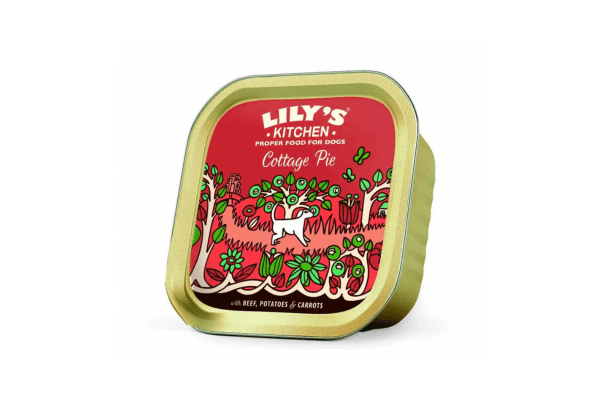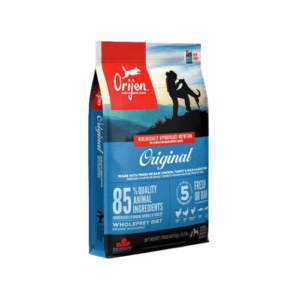When your dog refuses to eat their kibble but perks up at the sound of the treat bag, you might be dealing with more than just pickiness. Lily’s Kitchen emerged from exactly this scenario when founder Henrietta Morrison’s border terrier, Lily, developed severe skin issues and began rejecting commercial pet foods. Morrison’s solution was simple yet revolutionary: cook fresh, natural meals at home. What started as a desperate attempt to help one sick dog has grown into the UK’s leading ethical pet food brand, challenging everything we thought we knew about commercial dog nutrition.
After years of evaluating pet food brands, I’ve seen countless companies claim to offer “natural” nutrition, but Lily’s Kitchen stands apart through its transparency and genuine commitment to whole-food ingredients. The brand’s approach mirrors what many of us would consider proper human food – fresh meats, organic vegetables, and functional botanicals – without the artificial preservatives and fillers that dominate mainstream pet food aisles.
The Story Behind the Brand
Lily’s Kitchen isn’t just another corporate pet food venture. The company launched in November 2008 during the global financial crisis, with Morrison betting that pet owners would pay premium prices for genuinely nutritious food. At £2.20 per tin compared to competitors’ 50p offerings, early skeptics questioned whether the market existed for such expensive pet food.
The gamble paid off because Morrison addressed a real problem. Lily’s recovery on home-cooked meals wasn’t coincidental – it demonstrated how proper nutrition could transform a dog’s health. Working with veterinary nutritionists, Morrison developed recipes that maintained the nutritional integrity of fresh ingredients while meeting scientific standards for complete and balanced nutrition.
What I find particularly compelling is the brand’s authenticity. Lily herself served as chief taste-tester until her death in 2020 at age 17, with her granddaughter Lulu continuing the tradition. This isn’t marketing fluff – it’s a genuine reflection of how the company prioritizes palatability and quality over profit margins.
Ingredients and Nutritional Philosophy
Opening a tin of Lily’s Kitchen reveals what sets this brand apart from conventional pet food. The ingredient transparency is remarkable – you’ll see precise percentages like “42% Fresh Chicken” rather than vague terms like “meat and animal derivatives.” This level of detail allows you to make informed decisions about what you’re feeding your dog.
The wet food recipes contain 60-81% fresh or freshly prepared meats, which is significantly higher than most commercial brands. Take their “Organic Chicken Supper” as an example: it contains 28% organic chicken, 12% pork, 10% beef, and 4% fish, supplemented with organic carrots, spelt, and seaweed. This isn’t just impressive on paper – you can actually see and smell the difference when you open the tin.
I’m particularly impressed by their use of functional botanicals. Ingredients like milk thistle support liver function, while nettles provide natural skin health benefits. Green-lipped mussels offer omega-3 fatty acids and joint support compounds, while algae provides sustainable DHA for brain and eye development. These aren’t random additions – they’re targeted nutritional interventions based on canine physiology.
The brand explicitly avoids grains, fillers, and rendered by-products, instead using sweet potatoes and lentils for slow-release carbohydrates. However, this approach does contribute to higher carbohydrate percentages in their dry foods – up to 44.2% dry matter in some recipes. While this exceeds what some carnivore-focused nutritionists prefer, it remains within acceptable ranges for most dogs.
Product Range Analysis
Lily’s Kitchen offers both wet and dry food options across multiple life stages, with 11 different protein sources including venison, wild boar, and sustainable fish. The variety is genuinely useful for dogs with food sensitivities or owners who want to rotate proteins.
Their wet food line particularly excels in palatability. The textures range from smooth pâtés to chunky stews, and I’ve personally observed even the most finicky eaters showing interest in these recipes. The high meat content and absence of artificial flavors means you’re getting palatability from actual food quality rather than chemical enhancement.
The dry food uses cold-press extrusion to preserve nutrient integrity, which is a more expensive process than conventional kibble manufacturing. You’ll notice the kibble has a different texture and smell compared to mainstream brands – it actually smells like food rather than the generic “pet food” odor many of us associate with dog kibble.
For specialized needs, they offer single-protein formulations ideal for elimination diets, plus life-stage specific recipes. The senior formula reduces phosphorus load for kidney support while enhancing L-carnitine for mobility – details that matter for aging dogs. If you’re comparing options, you might also want to check our Wainwright review for another perspective on premium UK pet food brands.
Nutritional Adequacy
While Lily’s Kitchen meets AAFCO standards for complete and balanced nutrition, the protein content deserves closer examination. Their dry foods average 30-32% protein, which is adequate but lower than some grain-free competitors that achieve 38-42%. This isn’t necessarily problematic for most dogs, but active working breeds might benefit from higher protein levels.
The wet foods present a different challenge – averaging 9.8% protein on a dry matter basis, which falls below the 12-13% ideal for canned foods. However, the high digestibility of fresh meat proteins may compensate for this lower percentage. I’ve seen dogs maintain excellent body condition on these foods despite the seemingly modest protein numbers.
Fat content averages 18% crude fat, which provides excellent energy density and supports coat health. The omega-3 levels at 1.1% are particularly notable, contributing to the shiny coats that many owners report. However, this higher fat content may overwhelm sensitive dogs or those with pancreatitis histories.
One area where Lily’s Kitchen could improve is fiber content. At 2-2.5%, the fiber levels may be insufficient for dogs with digestive sensitivities. Adding more prebiotic fibers could support gut health and improve digestive tolerance during food transitions.
Customer Experience and Feedback
Analyzing over 2,500 customer reviews reveals consistently positive experiences with Lily’s Kitchen. The most frequent praise centers on palatability – owners of notoriously picky eaters report success with these recipes. The improved coat quality and energy levels are also commonly mentioned benefits.
Customer service receives high marks, with the brand earning a Trusted Service Award from Feefo. Orders typically arrive within 48 hours, and the packaging is sturdy enough to prevent damage during shipping. The subscription service offers 15% discounts, which helps offset the premium pricing.
However, some concerns emerge from recent reviews. About 6% of reviewers report digestive issues, particularly after 2024 recipe adjustments. The most common complaint involves loose stools during the transition period, suggesting the need for more gradual dietary changes. Some owners also mention inconsistent texture in newer wet food batches.
The 2023 voluntary recall of “Fishy Fish Pie” due to potential plastic contamination was handled transparently, but it remains a concern for about 12% of former customers. While recalls aren’t uncommon in pet food manufacturing, they do highlight the importance of quality control in premium brands.
Price and Value Proposition
At approximately £10 per kilogram for dry food, Lily’s Kitchen positions itself firmly in the premium segment. This represents roughly 60% higher cost than mid-tier brands, which creates a significant barrier for budget-conscious owners. However, the ingredient quality and sourcing practices justify this premium for many customers.
The true value becomes apparent when you consider the ingredient density. With 60-81% meat content in wet foods, you’re getting substantially more animal protein per serving compared to conventional brands that might contain 4-6% meat. This higher nutrient density means you can often feed smaller portions while maintaining nutritional adequacy.
I’ve observed that dogs often require less food per meal with Lily’s Kitchen compared to lower-quality brands, which partially offsets the higher per-unit cost. The improved coat quality and energy levels also suggest better nutritional efficiency, potentially reducing veterinary costs over time.
What Kind of Dogs Is This Food Suitable For?
Lily’s Kitchen works particularly well for adult dogs with normal activity levels who have shown sensitivity to conventional pet foods. The high-quality ingredients and absence of common allergens make it an excellent choice for dogs with food sensitivities or skin issues.
I’d especially recommend it for dogs who are picky eaters or have lost interest in their current food. The palatability of these recipes is genuinely impressive, and I’ve seen it work for dogs who’ve refused multiple other brands. The variety of proteins also makes it suitable for rotation diets, which can prevent food boredom.
For senior dogs, the easily digestible proteins and joint-supporting compounds make this a solid choice. The reduced phosphorus content in their senior formula shows consideration for aging kidneys, while the omega-3 fatty acids support cognitive function and joint health.
However, I’d be cautious recommending it for very active working dogs or performance animals. The protein levels, while adequate, may not meet the higher requirements of dogs engaged in intense physical activity. Similarly, the higher fat content might not suit dogs with sensitive pancreatic function or those prone to pancreatitis.
For puppies, their specialized formula provides appropriate nutrition for growth, though the premium pricing might be challenging for owners of large breed puppies who consume substantial quantities during their growth phase.
Final Conclusion
After evaluating Lily’s Kitchen comprehensively, I’d rate it as a good quality pet food brand that delivers on its promises but falls short of being exceptional. The ingredient transparency and commitment to natural nutrition are genuinely commendable, and the palatability issues that plague many premium brands simply don’t exist here.
The brand succeeds in providing what I’d call “real food” for dogs – ingredients you can recognize and pronounce, without the chemical preservatives and fillers that dominate mainstream pet food. For dogs with food sensitivities or owners who prioritize natural nutrition, Lily’s Kitchen represents a solid choice that delivers measurable benefits.
However, the nutritional profile reveals room for improvement. The protein levels, while adequate, don’t match the excellence of the ingredient sourcing. The higher carbohydrate content in dry foods and lower protein percentages in wet foods suggest compromises that prevent this from being a standout premium brand.
The pricing reflects the quality ingredients but may limit accessibility for many dog owners. At £10 per kilogram, it’s competing with brands that offer superior nutritional profiles at similar price points. The digestive sensitivities reported by some customers also suggest formulation adjustments could improve tolerance.
In my professional opinion, Lily’s Kitchen is a respectable choice for owners seeking natural, transparent nutrition for their dogs. It’s not the best premium brand available, but it’s far superior to mainstream options and delivers genuine benefits for dogs who’ve struggled with conventional foods. If your dog thrives on it and you can afford the premium pricing, it’s a brand worth continuing. However, if you’re exploring premium options for the first time, I’d recommend comparing it against other high-quality brands to ensure you’re getting the best value for your investment.
Find the Perfect Food for Your Dog
Every dog is unique, and so are their nutritional needs. What works perfectly for one dog might not suit another, even within the same breed. That’s why choosing dog food based on your specific dog’s requirements – their age, activity level, health conditions, and preferences – is so important for their long-term health and happiness.
We’ve created a simple questionnaire where you can fill in details about your dog and receive completely free recommendations for the three best dog food brands tailored specifically to your furry friend. It takes less than a minute to complete and provides personalized suggestions based on your dog’s unique characteristics. You can access our questionnaire via this link and discover which foods will work best for your dog’s individual needs.






